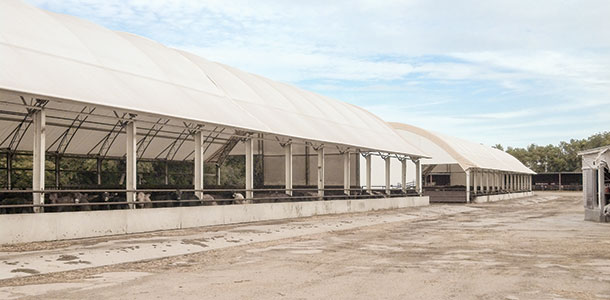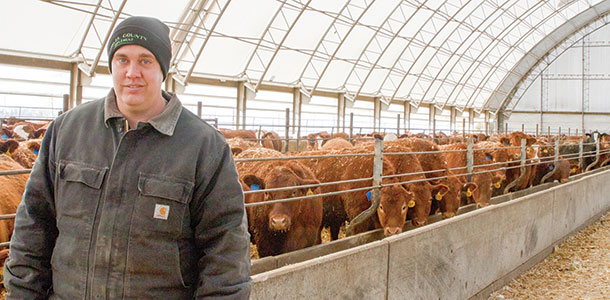For Worthington, Minnesota, cattle feeder Adam Blume, building a hoop barn in 2007 allowed him and his dad, Tim, to expand their operation from a 100-head open lot to a 700-head, 360-foot-long hoop barn.
The decision to build a hoop structure came after the pair had toured feedlots in the Lyon County, Minnesota, area and South Dakota in 2006.
Blume says that at the time they were leaning toward building a monoslope barn until after listening to a veterinarian in their group say the poorest air quality is in a monoslope.
At the time, monoslopes were wider than they are now, and a hoop barn cost about $200 to $300 per head less than a monoslope.
 “We went out to South Dakota and looked at a hoop barn and walked in, and we just couldn’t believe the air quality,” Blume says.
“We went out to South Dakota and looked at a hoop barn and walked in, and we just couldn’t believe the air quality,” Blume says.
While traditionally, hoop barns are set up with the feedbunk along an outer edge, the Blumes wanted everything under the roof.
“When we built this barn, we built it to be simple for one person to do it because it’s just myself that lives here with my fiancée and her two girls. If I’m not around, they know enough that they can close the curtains,” he says.
When the Blumes set up their facility, many people said the way they were doing it would never work. Many told them they were wasting space by putting the alley and bunks down the middle of the barn.
Many said the cattle would never figure out how to go around the fence through the pens that allow them to lock the cattle back when they scrape the feed alley.
Blume says that middle alley has been a benefit to their operation rather than a waste like many said it would be.
“Every day we feed down it and bed down it. We work our cattle down it. It’s used every single day,” Blume says. “It’s actually made for a really nice setup.”
He says they can put the cattle out in the middle when they clean out the pens, which they do every two months. He appreciates the fact that they do not have to set up a bunch of gates to work cattle or clean out pens.
Blume says the cattle had no problem figuring out the fences in the middle of the pens.
“People said they’ll never figure their way around the outside edges. Well, the first thing the cattle do when they get in the barn is run. They figure out they go around that to get to the feed and then around that to get back to the bedding,” he says. “We were worried when we first put it up because so many downed the things we did.”
Volga, South Dakota, producer Scott VanderWal has taken a more traditional approach with his two hoop barns – but with a twist.
VanderWal’s family has been running the operation on the same place a mile north of Volga since the 1940s. The operation consisted of open lots until 1978, when they built a slat-floor barn with a deep pit.
That barn is still in operation today – but only because they had found a rubber mat product to fit over the slats about four years ago.
He says the mats make it much more comfortable for the cattle, and they have had very few feet and leg issues since putting those in.
In 2009, VanderWal wanted to build another deep pit barn but could not because of a gas main that runs through their yard. Regulations say a permanent structure cannot be built over a gas line. As a result, they put up two 196-foot-by-70-foot hoop barns that run north and south and have a space in between where the gas line runs. Their feedbunk runs on the east side of the barns.
“That’s not ideal. Normally, you’d like to have the open area facing south for wind purposes in the summertime,” VanderWal says.
To make up for some of the natural airflow they would have gotten had their barns faced south, they installed fans on the west walls to run during the summer.
 VanderWal allows for 42 square feet per head. He has two pens in each barn where cattle stay anywhere from 90 to 200 days. Blume allows for 32 square feet per head. His pens are 175 feet long, and there are four pens in the barn.
VanderWal allows for 42 square feet per head. He has two pens in each barn where cattle stay anywhere from 90 to 200 days. Blume allows for 32 square feet per head. His pens are 175 feet long, and there are four pens in the barn.
While animal health has been good for VanderWal, he says managing the bedding has been the biggest challenge.
They bed about three times a week with a grinder that they drive on the apron outside the bunk, and it blows the bedding most of the way across. They are bedding with cornstalks.
VanderWal says the hoop barns are very labor-intensive. In the fall when they are busy with harvest and tillage work, they also have to be putting up 2,000 cornstalk bales that they use for bedding and in their feedlot ration.
Blume says they lightly bed their barn every day with cornstalks or bean straw. While that can be a tedious job, Blume thinks the fresh bedding helps with animal health and comfort.
“We’ve found that we’ve had good animal health just by keeping fresh bedding in there every day,” he says. “When something’s working for you, you just don’t change it.
I’ve even thought to myself that this bedding every day gets a little old, but we’re doing it inside so it’s no big deal, and we’re doing it lightly.”
Blume utilizes curtains on his hoop barn. After working through a few different types of curtains on the north and south side of the barn for a few years, they finally put in electric curtains about four years ago.
He says he would spend the money right away in the beginning on electric curtains rather than having to hand-crank and strap down every section.
“They’re not the cheapest, but boy, air quality, animal health, they’ve paid for themselves. They really have,” Blume says.
Blume recognizes that it was a bit of a learning curve getting used to a hoop barn. However, he says the health of the animals is fantastic and the air quality is great in their barn.
Out of the 700 head of colored cattle that came into the barn in the fall, he has not treated any. His cattle are all in a non-hormone-treated cattle (NHTC) program.
“There ain’t a building out there that’s going to beat a hoop barn for air quality and animal health. On a nice, sunny day, you go in there and it’s nice and bright,” Blume says. “A hoop barn gives you a lot of options.
I tell people you can start 200-pound Holsteins in here and finish 1,500-pound colored calves in here. You can do whatever you want in this barn. ![]()
Wendy Sweeter is a freelance writer based in South Dakota.
PHOTOS
PHOTO 1: Adam Blume stands in the middle alley in his hoop barn. Photo courtesy of Wendy Sweeter.
PHOTO 2: Two 196-foot hoop barns at VanderWal Farms. Photo courtesy of VanderWal Farms.
PHOTO 3: Adam Blume feeds 700 cattle in his 360-foot-long hoop barn. Photo courtesy of Wendy Sweeter.








